Stamps issued to cover basic telegraph rates.
- Australia 1901-1988
- New South Wales
- Overview of NSW
- Telegraph lines
- Telegraph Offices
- Date stamps
- Forms
- Envelopes
- Instructional annotation
- Collect
- Delayed
- Free
- Immediate Urgent
- Reply paid
- Rates
- Stamps
- 1871 Telegraph stamps
- 1885 proposal
- 1893 proposal
- Queensland
- South Australia
- Tasmania
- Victoria
- Western Australia
- International
- Special aspects
The Federal Post and Telegraph Act of 1901 was the first definition of requirements under the new Commonwealth auspices. It contained the following statements requiring the use of postage stamps:
Payment of Telegraph Rates by Postage stamps: Telegrams must be paid for by means of postage stamps, which the senders must affix to the forms.
The new provision for the payment of telegrams using stamps affixed to the message applies only to the Commonwealth. Cables to New Zealand or elsewhere must be paid for in cash.
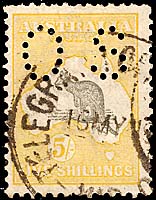 |
Telegrams sent for official purposes - by or or behalf of the Commonwealth or State Government Departments - could be prepaid by using perforated "O.S." postage stamps (see, for example, Post and Telegraph Guide, 1922, para 212). The example at the left has been date stamped at a Telegraph Office on 15 May 1919. |
The system through which payment was passed over the counter to pay for the stamps was open to manipulation. The following article comments on the results and reports on improvements whch could be made:
G.P.O. METHODS.
Magistrate's Strictures: 'A Rotten System.'
"Before Mr. A. B. Kidson. Acting P.M., in the City Court yesterday, the hearing was concluded of the charge against Francis G. Turner, an employee of the Central Post Office, Perth, of having stolen 10s. from the Postmaster-General. After a deal of argument, Mr. Kidson dismissed the charge, at the same time severely criticising some of the working methods employed at the G.P.O. Messrs. T. Ford and J. Mather. J.P.s sat on the Bench with Mr. Kidson.
The prosecution, represented by Mr. X. P. Lappin, alleged that Turner, when paid 10s. 8d. for two telegrams handed over the telegram counter in the GPO, placed only 8d. in the cash register till and stole the 10s. It was also alleged that the accused subsequently removed from the circulation room the telegram vouchers which alone could prove how much money was received by him. The record on the slip in the cash register seemed to show that only 8d had been paid into the till.
The prosecution, on Wednesday, brought evidence to show that many other telegrame handled by Turner had disappeared during the last two years. When the case came on yesterday, Mr F. Curran. representing the accused, asked the Bench to disallow the evidence about the disappearance of the other vouchers on the ground that that evidence was only that telegrams missing and did not show that the accused had anything to do with their disappearance. Mr. Kidson said he would bear Mr. Currin's application in mind.
The accused, in the witness-box, said he was sometimes employed at the telegram counter in the G.P.O. He could not remember receiving the two telegrams in question. He had never at any time stolen money from the till at the G.P.O. Mistakes might occur with the cash register in a number of ways. For instance, although 5s 4d. (in payment for one telegram) might actually be put in the till, the machine might record only 4d on the machine slip; and on the telegram itself. When the mistake was discovered, the telegram would be sent back from the circulation office marked 'Please adjust' and the clerk at the telegram counter would then buy stamps with the fee in the till and put them on the telegram. This would adjust matters. Although this procedure was not according to regulation, it was usual. In several other ways mistakes might occur. If the telegrams disappeared from the circulation room, after having been transmitted, that was not the accused's responsibility.
Mr. Curran contended that the evidence was insufficient to prove anything against the Accused. The system employed in the Telegraphic Department, he said, was rotten to the core. Hardly any of the regulations in the Telegraphic Department were observed.
Mr. Kidson, in delivering judgment, said the system employed in the Telegram Department in the G.P.O. seemed to be such that the sooner it was done away with the better it would be for the Department. It seemed to him that it placed the whole responsibility of handling money upon the integrity of the employee. The system was rotten and should not be allowed to remain for a day longer than necessary. If it had been a proper one, it might have been possible to bring evidence showing that the accused was guilty. The circumstances of the case were not without suspicion, but he could not convict the accused on suspicion; he would dismiss the charge but he would not allow the accused any costs.
The Magistrate's pronouncement was greeted by an outburst of applause from persons in the back of the court".
The West Australian 15 October 1926.
The page below shows the definitive and commemorative postage stamps issued to pay:
- the intrastate rates;
- the interstate rates (to 1940);
- beyond a 15 mile radius (after the 1940 rate changes);
- the make-up rates for more expensive telegrams.
Full details of the actual rates are included eleswhere.
NOTE: Australian Commonwealth Specialists' Catalogue numbers (ACSC #) have been given for each stamp. Multiple numbers indicate watermark and die variations. No attempt is made to show stamps in relative sizes (except for the Lyrebirds).
Intrastate rate - to 1940.
The intrastate rate was set at 9d in 1913 and raised to 1/- in 1920. It was maintained at 1/- until 10 June 1940 when the Act was revised to allow the 15 miles limit to cross state boundaries. From then on, the interstate rate was discontinued.
Seven stamps were issued over the period to pay the basic intrastate rate for ordinary telegrams - four definitive issues and three commemorative issues. No special denominations were issued for urgent rate telegrams. The stamps issued are:
| Definitives. | |||
 |
 |
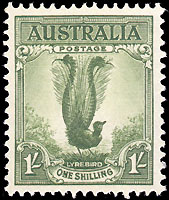 |
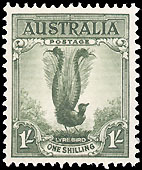 |
9d violet Kangaroo of Map. Paid the intrastate rate until ACSC # 24-26. |
1/- emerald Kangaroo on Map. Paid the intrastate rate from October 1920 until its replacement in February 1932. ACSC # 30-33 |
1/- green Lyrebird. Paid the intrastate rate from ACSC # 145. |
1/- green Lyrebird. Paid the intrastate rate from ACSC # 208. |
Commemoratives.
 |
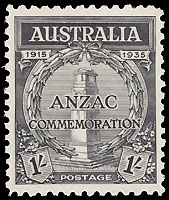 |
 |
1/- black Centenary of Victoria. Supplemented the 1/- Lyrebird. ACSC # 153 & 156. |
1/- black 20th Anniversary of Supplemented the 1/- Lyrebird. ACSC # 165. |
1/- green Centenary of South Australia. Supplemented the 1/- Lyrebird. ACSC # 173. |
Interstate rate - until 1940.
The interstate rate was set at 1/- in 1913 and raised to 1/4 in 1920. It was maintained at 1/4 until mid-1940.
Three stamps were issued over the period to pay the basic interstate rate for ordinary telegrams. All were definitive issues.
The stamps issued are:
Definitives.
 |
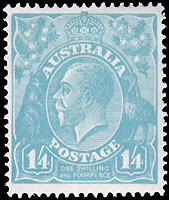 |
 |
1/- emerald Kangaroo on Map. Paid the interstate rate until it was raised on 1 October 1923. ACSC # 30-34. |
1/4 turquoise King George V. Paid the interstate rate until ACSC # 128-131. |
1/4 magenta King George VI. Paid the interstate rate until ACSC # 211. |
"Beyond 15 mile" rate - 1940 to 1965.
As noted in the rates tables, the changes made to telegraph charges in 1940 altered the structure to two tiers:
- less than 15 miles;
- greater than 15 miles.
State was no longer a consideration in determining charges.
No stamp was targetted for the "less than 15 miles" rate as a stamp for that rate was always available for pacels and for various postal rates.
The "over 15 miles" rates have stamps which were usually used although they did often relate to other postal rates especially higher steps for heavier articles.
Definitives issued 1940 to 1965.
| 1949 rate change to 1/6. | 1950 rate change to 2/-. | 1951 rate change to 2/6. | 1958 rate change - 3/- for 12 words including State. | |
 |
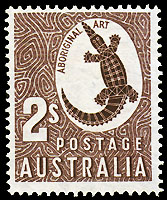 |
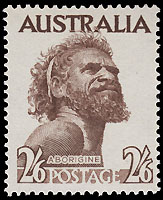 |
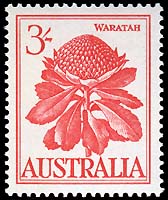 |
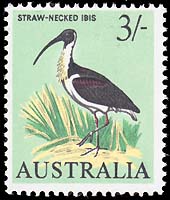 |
| 1/6 grey-black Hermes. Issued 1 September 1949. ACSC # 261-262. The Hermes image was also printed on the reverse side of ssome telegrams during the 1930s. |
2/- chocolate Aboriginal Art Issued 16 February 1948. ACSC # 263. |
2/6 sepia Aborgine ("One Pound Jimmy"). Issued 19 March 1952. ACSC # 265. |
3/- rose-red Waratah. Issued July 1959. Replaced by 3/- Ibis in 1965. Paid the basic telegram rate for 12 words 1958-1965. ACSC # 372. |
3/- Straw-necked Ibis. Issued April 1965. Paid the basic telegram rate for 12 words until decimal currency introduced 1966. ACSC # 422. |
| Examples of use on telegrams (1958-1965). | ||||
Commemorative issued 1940 to 1965.
| 1940 1/- rate for 14 words.
Only one 1/- Commemorative stamp was issued during this period. |
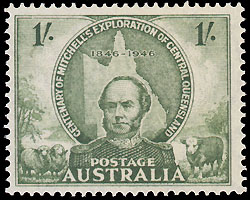 |
1/- dull green Centenary of Mitchell's Exploration of Central Queensland. Issued October 1946. Supplememted the 1/- Lyrebird. ACSC # 241. |
Make-up denominations for more expensive telegrams.
Various denominations were issued to cover more expensive telegrams including those sent at the urgent rate (double the ordinary rate). Many telegrams exceed the basic quota of 16 words and so stamps could be added in a suitable way to achieve the total cost.
The main denominations were 2/-, 2/6, 4/-, 5/-, 10/-, £1 and £2. Except for two stamps, all were definitive issues.
The Kangaroos on Map
 |
 |
 |
 |
| 2/- brown. Issued 30 January 1913. ACSC # 35-37. |
2/- maroon. Issued 1 May 1924. ACSC # 38-40. |
2/- maroon (redrawn die). Issued 24 December 1945. ACSC # 41. |
5/- grey and chrome. Issued 20 March 1913. ACSC # 42-46. |
 |
 |
 |
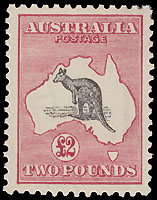 |
| 10/- grey and pink. Issued 20 March 1913. ACSC # 47-50. |
£1 brown and blue. Issued 20 March 1913. ACSC# 51-52. |
£1 grey. Issued 1 May 1924. ACSC# 53-54. |
£2 black and rose. Issued 8 April 1913. ACSC # 55-58. |
Pre-decimal definitives
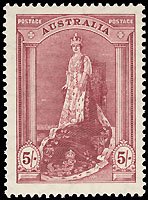 |
 |
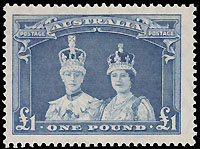 |
|
5/- reddish-lake Coronation Robes. |
10/- dull purple Coronation Robes. ACSC # 214-215. |
£1 dull blue Coronation Robes. ACSC # 216-216. |
|
 |
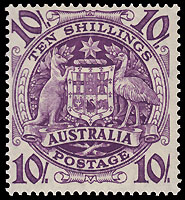 |
 |
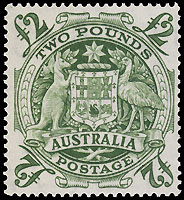 |
5/- Carmine Coat-of-Arms. ACSC # 268. |
10/- purple Coat-of-Arms. ACSC # 269. |
£1 blue Coat-of-Arms. ACSC # 270. |
£2 green Coat-of-Arms. ACSC # 271. |
For examples of the use of the Arms stamps for telegram use, see
|
|||

|
5/- reddish-brown Cattle Industry. Issued 26 July 1961. ACSC # 373. |
||
 |
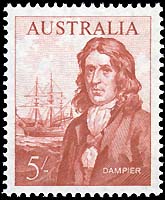 |
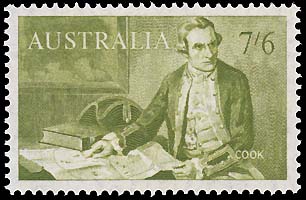 |
4/- blue Abel Tasman. ACSC # 404. |
5/- red-brown William Dampier. ACSC # 405. |
7/6 olive-green James Cook. ACSC # 406. |
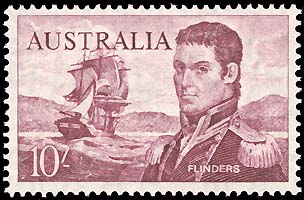 |
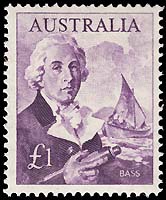 |
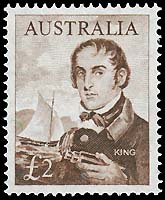 |
10/- maroon Matthew Flinders.. ACSC # 407. |
£1 purple George Bass. ACSC # 408. |
£2 blackish-brown Phillip Parker King. ACSC # 409. |
Pre-decimal commemoratives
 |
 |
|
5/- dark green ACSC #148. |
2/- Violet ACSC # 168. |
Decimal definitives
 |
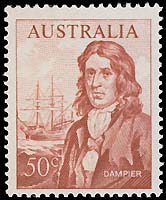 |
 |
40c blue Abel Tasman. ACSC # 460. |
50c red-brown William Dampier. ACSC # 461. |
50c olive-green James Cook. ACSC # 462. |
 |
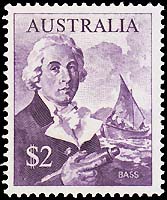 |
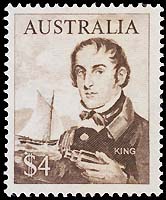 |
$1 maroon Matthew Flinders. ACSC # 463-464. |
$2 purple George Bass. ACSC # 465. |
$4 blackish-brown Phillip Parker King. ACSC # 466. |
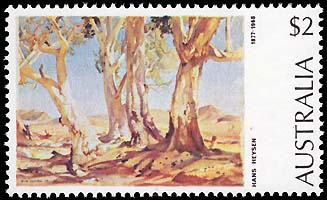 |
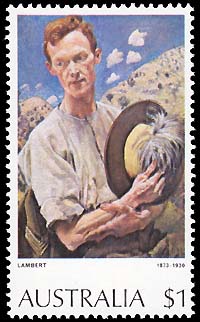 |
 |
| $2 multicolour "Red Gums of Far North" Issued 24 April 1974. ACSC # 665. |
$1 "Sergeant of Light Horse". Issued 24 April 1974. ACSC # 664. |
$4 multicolour "Shearing Rams". Issued 24 April 1974. ACSC # 666. |
By the early 1970s, ordinary postage stamps in large quantities of lower value definitives were often used to pay telegram costs. Examples of some of these usages are:
| AT-TO-14B and others on that page. | 11 January 1977 | Use of 15c Christmas, 3c Coral Crab $5 Mentone, $1 Corriedale sheep, etc. |